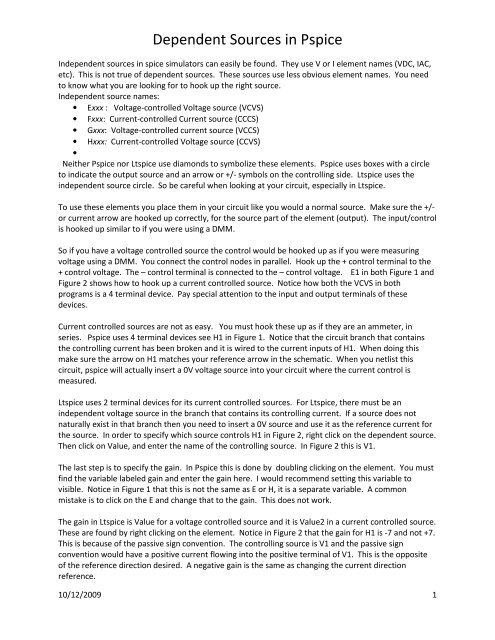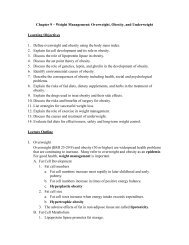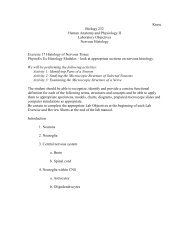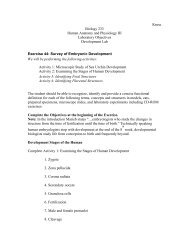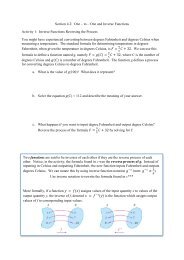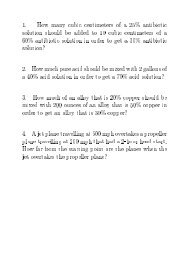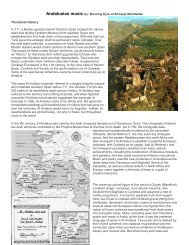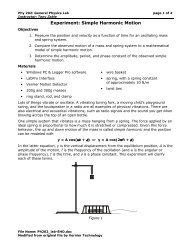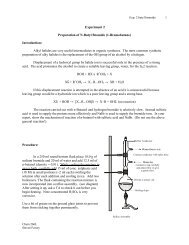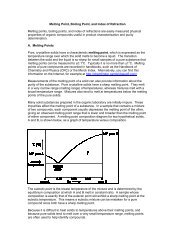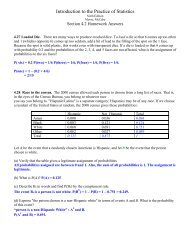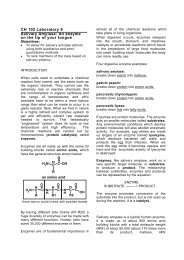Dependent Sources in Pspice - PCC
Dependent Sources in Pspice - PCC
Dependent Sources in Pspice - PCC
You also want an ePaper? Increase the reach of your titles
YUMPU automatically turns print PDFs into web optimized ePapers that Google loves.
<strong>Dependent</strong> <strong>Sources</strong> <strong>in</strong> <strong>Pspice</strong><br />
Independent sources <strong>in</strong> spice simulators can easily be found. They use V or I element names (VDC, IAC,<br />
etc). This is not true of dependent sources. These sources use less obvious element names. You need<br />
to know what you are look<strong>in</strong>g for to hook up the right source.<br />
Independent source names:<br />
• Exxx : Voltage-controlled Voltage source (VCVS)<br />
• Fxxx: Current-controlled Current source (CCCS)<br />
• Gxxx: Voltage-controlled current source (VCCS)<br />
• Hxxx: Current-controlled Voltage source (CCVS)<br />
•<br />
Neither <strong>Pspice</strong> nor Ltspice use diamonds to symbolize these elements. <strong>Pspice</strong> uses boxes with a circle<br />
to <strong>in</strong>dicate the output source and an arrow or +/- symbols on the controll<strong>in</strong>g side. Ltspice uses the<br />
<strong>in</strong>dependent source circle. So be careful when look<strong>in</strong>g at your circuit, especially <strong>in</strong> Ltspice.<br />
To use these elements you place them <strong>in</strong> your circuit like you would a normal source. Make sure the +/-<br />
or current arrow are hooked up correctly, for the source part of the element (output). The <strong>in</strong>put/control<br />
is hooked up similar to if you were us<strong>in</strong>g a DMM.<br />
So if you have a voltage controlled source the control would be hooked up as if you were measur<strong>in</strong>g<br />
voltage us<strong>in</strong>g a DMM. You connect the control nodes <strong>in</strong> parallel. Hook up the + control term<strong>in</strong>al to the<br />
+ control voltage. The – control term<strong>in</strong>al is connected to the – control voltage. E1 <strong>in</strong> both Figure 1 and<br />
Figure 2 shows how to hook up a current controlled source. Notice how both the VCVS <strong>in</strong> both<br />
programs is a 4 term<strong>in</strong>al device. Pay special attention to the <strong>in</strong>put and output term<strong>in</strong>als of these<br />
devices.<br />
Current controlled sources are not as easy. You must hook these up as if they are an ammeter, <strong>in</strong><br />
series. <strong>Pspice</strong> uses 4 term<strong>in</strong>al devices see H1 <strong>in</strong> Figure 1. Notice that the circuit branch that conta<strong>in</strong>s<br />
the controll<strong>in</strong>g current has been broken and it is wired to the current <strong>in</strong>puts of H1. When do<strong>in</strong>g this<br />
make sure the arrow on H1 matches your reference arrow <strong>in</strong> the schematic. When you netlist this<br />
circuit, pspice will actually <strong>in</strong>sert a 0V voltage source <strong>in</strong>to your circuit where the current control is<br />
measured.<br />
Ltspice uses 2 term<strong>in</strong>al devices for its current controlled sources. For Ltspice, there must be an<br />
<strong>in</strong>dependent voltage source <strong>in</strong> the branch that conta<strong>in</strong>s its controll<strong>in</strong>g current. If a source does not<br />
naturally exist <strong>in</strong> that branch then you need to <strong>in</strong>sert a 0V source and use it as the reference current for<br />
the source. In order to specify which source controls H1 <strong>in</strong> Figure 2, right click on the dependent source.<br />
Then click on Value, and enter the name of the controll<strong>in</strong>g source. In Figure 2 this is V1.<br />
The last step is to specify the ga<strong>in</strong>. In <strong>Pspice</strong> this is done by doubl<strong>in</strong>g click<strong>in</strong>g on the element. You must<br />
f<strong>in</strong>d the variable labeled ga<strong>in</strong> and enter the ga<strong>in</strong> here. I would recommend sett<strong>in</strong>g this variable to<br />
visible. Notice <strong>in</strong> Figure 1 that this is not the same as E or H, it is a separate variable. A common<br />
mistake is to click on the E and change that to the ga<strong>in</strong>. This does not work.<br />
The ga<strong>in</strong> <strong>in</strong> Ltspice is Value for a voltage controlled source and it is Value2 <strong>in</strong> a current controlled source.<br />
These are found by right click<strong>in</strong>g on the element. Notice <strong>in</strong> Figure 2 that the ga<strong>in</strong> for H1 is -7 and not +7.<br />
This is because of the passive sign convention. The controll<strong>in</strong>g source is V1 and the passive sign<br />
convention would have a positive current flow<strong>in</strong>g <strong>in</strong>to the positive term<strong>in</strong>al of V1. This is the opposite<br />
of the reference direction desired. A negative ga<strong>in</strong> is the same as chang<strong>in</strong>g the current direction<br />
reference.<br />
10/12/2009 1
<strong>Dependent</strong> <strong>Sources</strong> <strong>in</strong> <strong>Pspice</strong><br />
Other references and thoughts:<br />
I really recommend gett<strong>in</strong>g some sort of simple Spice reference manual.<br />
List<strong>in</strong>g of possible PSPICE books from Powells :<br />
http://www.powells.com/s3?kw=spice&start=1&vaguesection=Electricity<br />
The books $
Figure 2 Mesh Example 2 <strong>in</strong> Ltspice<br />
<strong>Dependent</strong> <strong>Sources</strong> <strong>in</strong> <strong>Pspice</strong><br />
10/12/2009 3


